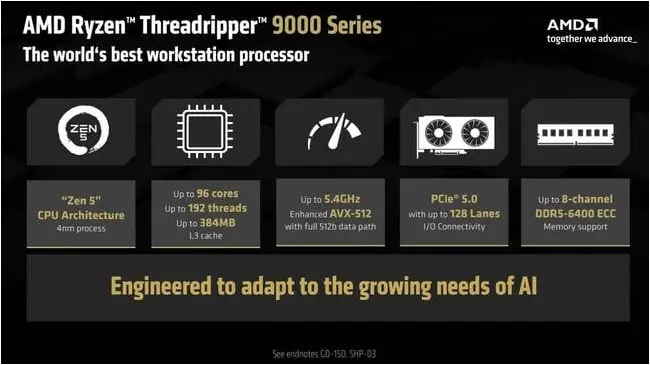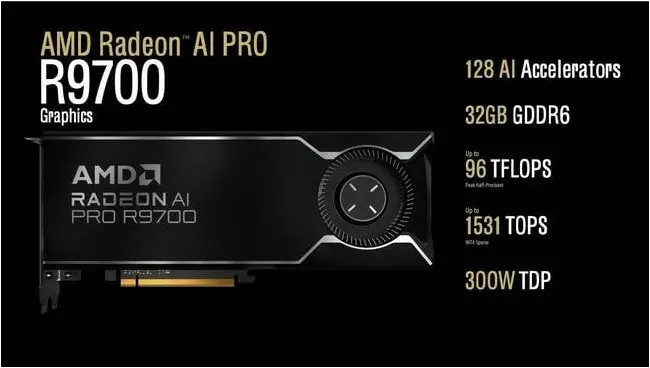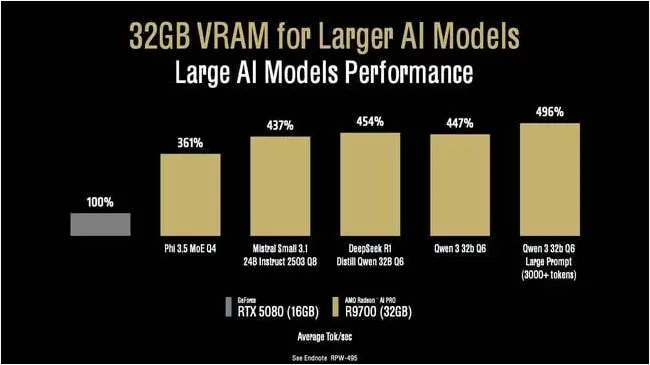Amd Puts Intel In Rear View Mirror With Threadripper Pro 9000 High End Desktopchips
Computex AMD aims to extend its lead over Intel in the high-end desktop (HEDT) and workstation arenas with its 9000-series Threadripper workstation CPUs teased at Computex this week.
Compared to previous Threadrippers (TR), the 9000 series appears to be a fairly sedate update with most of the gains coming from process improvements and the move to AMD’s Zen 5 microarchitecture.
Launched alongside its 9000-series Ryzen Desktop chips last summer, AMD’s Zen 5 architecture delivered a 16 percent uplift in instructions per clock over Zen 4. Since then, AMD has brought the architecture to its Epyc datacenter and now its Threadripper workstation processor families.

Here’s a quick rundown of AMD’s 9000-series Threadrippers, emphasis on ‘up to’ … Click to enlarge any pic
Like last gen, AMD’s latest Threadrippers are available in both Pro and Non-Pro variants with up to 96 cores, 128 lanes of PCIe 5.0, eight channels of DDR5 6400 MT/s memory with ECC support, and boost clocks up to 5.4GHz across the entire lineup.
Specifically, AMD’s workstation-class TR Pro 9000 parts will be available in SKUs ranging from 12 to 96 cores, while the non-Pro HEDT variants will have a condensed offering ranging from 24 to 64 cores.
Historically, AMD’s non-Pro Threadrippers have featured fewer memory channels and PCIe lanes than the Pro counterparts. For example, AMD’s TR 7000-series parts, launched in 2023, had four fewer channels of DDR5 and just 48 lanes of PCIe 5.0 connectivity compared to eight channels and 128 lanes on the Pro variant.
We’ve asked AMD for clarification on whether this will be the case for TR and TR Pro 9000.
Here’s a breakdown of Threadripper parts announced today:
Threadripper Pro 9000
| SKU | Cores | Threads | Boost Clock | Base Clock | L3 | TDP |
|---|---|---|---|---|---|---|
| 9995WX | 96 | 192 | 5.4GHz | 2.5GHz | 384MB | 350W |
| 9985WX | 64 | 128 | 5.4GHz | 3.2GHz | 256MB | 350W |
| 9975WX | 32 | 64 | 5.4GHz | 4.0GHz | 128MB | 350W |
| 9965WX | 24 | 48 | 5.4GHz | 4.2GHz | 128MB | 350W |
| 9955WX | 16 | 32 | 5.4GHz | 4.5GHz | 64MB | 350W |
| 9945WX | 12 | 24 | 5.4GHz | 4.7GHz | 64MB | 350W |
Threadripper 9000
| SKU | Cores | Threads | Boost Clock | Base Clock | L3 | TDP |
|---|---|---|---|---|---|---|
| 9980X | 64 | 128 | 5.4GHz | 3.2GHz | 256MB | 350W |
| 9970X | 32 | 64 | 5.4GHz | 4.0GHz | 128MB | 350W |
| 9960X | 24 | 48 | 5.4GHz | 4.2GHz | 128MB | 350W |
AMD hasn’t provided retail pricing for its latest crop of Threadrippers ahead of its Computex keynote this week. With that said, Threadripper is pretty much uncontested in the HEDT arena so they can charge whatever the market can bear.
Intel’s latest generation of workstation parts, launched last summer, are based on its now two-year-old Sapphire Rapids platform and top out at 60 cores, 112 lanes of PCIe 5.0, and eight lanes of DDR5 4800 MT/s memory.
AMD’s 9000-series Threadrippers are slated to make their debut in July.
RDNA 4 makes its workstation debut
Launching alongside its new Threadrippers, AMD also teased a new workstation GPU which features its new RDNA 4 graphics architecture and 32GB of vRAM on board.
The Radeon AI Pro R9700 appears to be based on the chip biz’s previously announced RX 9070 XT graphics cards, featuring the same 128 AI accelerators, which in this case are good for 96 teraFLOPS of FP16 and 1531 TOPS of sparse INT4 performance.
As we previously discussed, AMD’s RDNA 4 architecture brings with it a number of major performance improvements for AI workloads, including support for hardware sparsity and FP8 datatypes.
Note: At the time of writing, AMD had not yet shared retail pricing for the R9700.
Compared to the Intel Arc Pro B60 we looked at yesterday, the 300-watt R9700 should deliver about twice the performance in dense INT8 workloads, such as AI inferencing, and up to 4x the perf if you’re willing to give up some quality by dropping down to 4-bit precision.
However, the chip still falls short of Nvidia’s top workstation hardware. The GPU giant’s RTX Pro 6000 workstation cards announced back at GTC in March boast 96GB of vRAM and up to 4 petaOPS of sparse INT4 performance, making them about 2.6x faster than AMD’s latest generation of professional graphics.
Perhaps this is why AMD has opted to compare the R9700 against Nvidia’s consumer-focused RTX 5080, which it says offers up to 496 percent higher performance when running large AI models.
While that may sound impressive, the chart is rather misleading and only really tells us that more vRAM lets you run bigger models without paging out to slower system memory.
What AMD appears to have done is cherry-pick models too large to fit into the RTX 5080’s 16GB of vRAM, forcing them to spill over into the system’s slower DRAM. As you might have already guessed, this absolutely kills performance on memory bandwidth-bound workloads like AI inference.
If you reran these same tests with a smaller model that does fit into the 5080’s vRAM, like Qwen 3 14B Q4, we expect the results would look quite a bit different. That’s because, while both cards feature a 256-bit wide memory controller, the 5080 uses much faster GDDR7 memory modules. Combined, the 5080 achieves 960GB/s of memory bandwidth.
AMD hasn’t shared memory bandwidth figures for the R9700, but assuming it’s close to the 9070 XT’s 640GB/s, we estimate the 5080 to be about 1.5x faster.
When it comes to AI, fast memory won’t do you much good if you don’t have enough of it to fit your model. So, AMD isn’t entirely without merit; there are just less misleading ways to get this point across.
The R9700 is slated to hit shelves alongside AMD’s Threadripper CPUs in July. ®
A considerable amount of time and effort goes into maintaining this website, creating backend automation and creating new features and content for you to make actionable intelligence decisions. Everyone that supports the site helps enable new functionality.
If you like the site, please support us on “Patreon” or “Buy Me A Coffee” using the buttons below
To keep up to date follow us on the below channels.




